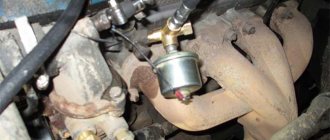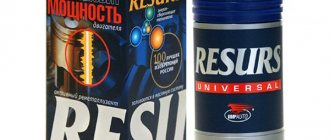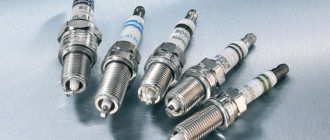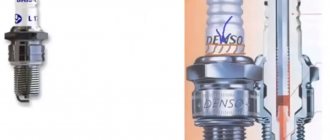If the author were asked to invent a new science, I would focus on automotive gerontology. And she would study the aging of car engines, just as her human counterpart studies the aging of our bodies. After 100 thousand km. and the first major overhaul, the car engine requires special care, in particular, selection of oil. How to choose it correctly?
How to change the oil yourself?
The oil has its own permanent place under the hood, shaped like a canister and connected to the engine with hoses. When a spark is supplied to the combustible mixture, oil is pumped from the container into the engine crankcase, where it fills all the space, washes the moving pistons, cools the internal combustion engine, and flows heated into the sump, from where it returns again to the container, where it mixes with cold oil and cools. A kind of circulation of oily liquid occurs. It is because of this circulation that the volume of oil to be replaced in the engine exceeds the capacity of the car engine itself.
If the oil movement system is well-functioning, the seals and filters do not leak, then the oil volume remains unchanged for a long time. But sometimes leaks appear due to worn out seals, poorly connected hoses, or a loose drain hole, and the fluid level drops. Accordingly, the pressure drops, and you have to constantly top it up.
The crankcase has 2 holes - a drain, which is located in the bottom, and a filler, through which it is filled.
It is not recommended to perform any manipulations with the oil immediately after turning off the engine, because it will be very hot and you can get burned by it. Before draining the oil product from the crankcase, or performing repair and maintenance work, the engine must also cool down.
But still, to reduce viscosity and improve fluidity, it is desirable that the oil be tolerably warm. When the engine is cold after being idle, it is worth starting it for a short time.
It is better to change used oil on a lift or in a pit. Please note that on most new cars, especially foreign cars, the engine is protected from above by a casing. It must be removed before starting work. At the bottom, the metal casing protecting the oil pan is removed.
The oil filler cap is unscrewed from above. This is necessary so that a vacuum does not form in the crankcase, and the air penetrating into the container pushes out the drained liquid. Place a convenient container (for example, a small bucket) under the crankcase drain hole, and unscrew the drain hole cover. And while the waste oil product is drained, you can unscrew the oil filter. Keep in mind that a small amount of waste oily liquid will also leak out from under the filter; place some kind of container under it as well.
The oil will drain for 10-12 minutes. Take your time. Allow the waste fluid to drain completely. Then pour in about 0.5-1 liters of fresh oil, and let it flow through the system, washing away the remnants of the old one. When all the liquid has flowed out, screw on the drain cap, set the bucket aside, install the oil filter and pour new oil through the funnel, previously purchased at an auto parts store.
Important. If you change the oil filter, be sure to pour a little oil into it so that the engine does not experience oil starvation in the first seconds of operation. When installing the new filter in place, do not overtighten so as not to damage the rubber seal.
After you fill in the oil, replace the casings and check the level with a dipstick, start the engine for 5 minutes, let the lubricating fluid fill the entire volume. Then check the level again with the dipstick. If it is lower, top up and tighten the oil filler neck tightly. Pay attention to whether there are any leaks under the machine from the filter or drain hole.
Next, you will find out how much oil you need to fill in the engine of various models and brands of cars.
Recommendations for filling lubricant
How to properly add oil to the engine? This question is asked by many novice drivers. The entire process of adding oil to the engine includes a number of basic operations that any motorist can handle.
Initially, you should open the hood of the car and secure it with a metal hook or rod. The hood of a car is usually opened by pressing a lever that is located below the level of the driver's left knee. Next, pull the lever under the hood.
After this, you need to find the oil filler neck sealed with a cap. It is located on the engine cylinder block. Usually there is an inscription “Oil Fill” on it or a marking of the viscosity of the oil used, for example, 5W30. The lid is unscrewed, wiped with a clean rag and left aside.
A funnel is inserted into the open space. It is necessary to prevent engine oil from spilling into the cylinders. Add oil in small portions. Turning oil containers upside down is not allowed. You need to pour about 200 ml per session, then wait 20 minutes for the engine oil to flow into the base of the crankcase. After a fresh portion of lubricant has settled at the base of the crankcase, its level is checked with a metal rod. If there is not enough car oil, you can repeat the topping up operation until the lubricant level approaches the nominal level, between the minimum and maximum values. The oil rod for checking the lubricant level must be wiped with a dry cloth before each check.
If a little motor oil gets into the engine area, then there is no need to panic. Lubricant residues become dangerous when a strong smell of burnt oil occurs after the engine warms up. It is advisable to clean the spill area with a dry cloth or paper towel.
When the engine fluid level reaches the optimum level, it is necessary to fix the oil dipstick and the filler cap back into place. The main thing is that everything is tightly screwed.
All unnecessary items are removed from the engine compartment, and the lid is closed. Next, you need to start the engine and let it idle for some time. At this time, the driver should carefully listen to the operation of the power device to identify extraneous sounds and noise. If the “Check Engine” sensor is triggered, the driver should immediately visit a car repair shop.
Now we know how to properly add oil to the engine, and whether it is possible to add oil to a hot engine. Timely topping up of lubricant allows you to save the life of your car engine. This means that all working parts of the power unit will be lubricated in a timely manner and protected from oil starvation and other undesirable factors.
Using quality lubricants
- The use of proven motor lubricants can significantly increase the operating time of a car engine. Also, branded lubricants support the machine’s engine at the most optimal level in all key indicators.
- For standard gasoline engines, I would recommend Shell 5W20 series lubricants, which can be replaced quite easily and which practically do not become dirty during operation.
Shell lubricants are light in color. These lubricants are the highest quality products from the entire company series and can be used on any car. I would note its high environmental friendliness and the fact that the product practically does not leave scale on the cylinders after operation. Also, the lubricant does not create soot during operation. The only drawback of the product is its rather high cost.
At its core, this automobile oil is perfect for the operation of engines of almost all cars. It is used in all-wheel drive cars of Mercedes and other brands, and can also be poured into cars of domestic brands. The lubricant can be used in manual transmissions and internal transfer cases, but only if the manufacturer has specified the use of the 5w90 class.
Checking the quality of motor lubricant
Experienced specialists check the quantity and condition of the oil based on its type. If you can see the minimum and maximum values through the drop on the dipstick, this fluid can be used in the car for some time.
This knowledge will be more than enough to change the lubricant yourself. The most important thing here is to try to carefully monitor the condition of the engine and manage to repair breakdowns in time. And in this case, the car will delight you with reliability for many years.
Separation of lubricants by origin
Today, all motor oils are divided by origin into mineral, synthetic and semi-synthetic. The latter type of oils is very common in the Russian Federation.
Experts advise that when using a motor, strictly follow the instructions for using a certain type of lubricant. Sometimes high-quality synthetics can damage the power unit instead of ensuring reliability and durability of its operation.
For example, if you replace mineral water with synthetics, you may run into trouble. Synthetic lubricant is not suitable for high mileage engines. Instead of reducing wear on the seals, it simply punctures them.
You need to be careful if you decide to choose semi-synthetics for a dead engine. It is better than mineral lubricant, but it is more fluid. This can have a bad effect on internal combustion engines with high mileage. In view of this, if you need to select oil for a worn-out engine, be sure to consult with an employee of the official dealership.
We recommend: What does your car smell like? We determine the malfunction by smell
If you have driven more than a hundred thousand kilometers in your car, you need to pour mineral water into the internal combustion engine. This is especially true for Russian cars. Remember that a worn engine uses a lot of lubricant. Mineral motor oil is inexpensive, so it is an excellent choice.
Semi-synthetics are a combination of mineral water and synthetics. For old Russian cars, its use is fraught with damage to the rubber parts of the engine. This is due to the fact that many aggressive additives are added to this type of motor oil.
Intervals when you need to replace
The service book for the vehicle specifies the mileage after which the lubricant solution must be replaced. In the absence of intense operating conditions, driving on the highway outside the city, the mileage between lubricant changes can be up to 15,000 km. Operating vehicles in city traffic will reduce mileage to 9000-11000 km. But these data are not completely accurate, since the condition of the lubricant is influenced by several factors, which include:
- Type and quality condition of the fuel being filled.
- Power plant volume.
- The type of lubricant that was previously filled and its condition.
- The number of hours worked by the engine.
- Technical condition of the vehicle.
- Vehicle operating conditions and power plant operating modes.
These factors can change the quality of the lubricant. Loss of its characteristics by the lubricant will lead to rapid wear of the power plant. In such a situation, an analysis of the oil solution carried out in laboratory conditions can give an accurate answer about the quality of the lubricant and the need to replace it.
How to check the oil level correctly
The procedure for checking the lubricant level is simple. It must be done daily before leaving the car.
Before checking the condition of the oil level in the engine, a number of technical conditions must be met:
- The car must be parked on a level surface. Tilts will lead to false readings.
- Free access to the measuring probe.
- The check is carried out on a warm engine.
The oil level is measured in the following order:
- The car engine warms up to 50 degrees.
- Wait 20 minutes to allow the lubricant to drain into the crankcase.
- Then you need to open the hood and pull out the dipstick.
- Insert it back into the car engine and wait a few seconds.
- You should pull out the dipstick and check the oil level.
The dipstick has maximum and minimum marks. The normal level is considered if the oil trace is between these marks.
Dipstick with marked marks
Determining measurement results
Channel No. 6 Garage shows the procedure for checking the oil level in a car.
Consequences of excess and deficiency
The rule states that the amount of oil fluid when the engine is warm should be at the middle level of the dipstick, between the min and max marks. How to measure it correctly? You need to warm up the engine to operating temperature by taking it for a short drive. Then stop the car on level ground, turn off the engine and wait 15–20 minutes until the oil mixture drains into the crankcase. After this, open the hood, remove the dipstick and wipe it dry with a rag. Then it is inserted again, and the level is measured, which is clearly visible along the edge of the oil strip. If this edge is located between the min and max marks, you don’t have to worry as you continue to drive the car. But if it goes beyond this zone, there can be serious trouble.
Other causes of lubricant leakage
In addition to those that occur most often and are described above, there may be other reasons when, knowing how much oil needs to be poured into the engine normally and having provided it, you have to add it more and more:
- the intake manifold control system is broken;
- the engine fluid level sensor has lost its seal;
- the filter element is not sealed;
- too much oil is poured in, which causes its operating pressure to increase - because of this, the load on the rings and oil seal increases, which can also become unusable;
- non-use of transport for a long period of time, when due to inactivity the sealing elements with seals may dry out;
- poor level of ventilation - if gases collect in the crankcase, the pressure in the system will be critical and will begin to squeeze out consumables.
So, now it is clear how much oil is needed in the engine when replacing and topping up during normal operation. If more is required during operation, this indicates emerging problems that are best solved without waiting for more global ones to appear.
The amount of oil in the engine differs depending on the make of the car. According to the standard, domestic cars are characterized by a lower capacity than foreign cars. Oil should be poured into the engine correctly, taking into account the characteristics of the vehicle. Otherwise, there is a possibility that all components of the car under the hood will flood.
The amount of oil in the engine differs depending on the make of the car.
What do you need to know before adding engine mixture?
Before adding engine oil to the engine, you need to find out what kind of fluid is in the power unit. If you just purchased a car, check this information with the previous owner of the car. Then buy oil of the same brand and viscosity. We recommend that you look at the car's operating book and find out the viscosity of the engine fluid necessary for the normal operation of the power unit of your vehicle. Before buying a mixture, read the car oil labeling - this will help you buy quality products and not fakes.
You need to add engine fluid if its level is below about on the dipstick. Keep in mind that when the drive is hot, the oil is inside it, and when the power unit is not warmed up, the engine mixture flows to the sump. The oil level immediately after driving will be lower, because the oil expands and flows through all engine components. For more reliable measurements, it is worth letting the engine sit for 15-20 minutes after stopping it - this time is enough for the power unit to cool and the liquid to drain to the sump.
In cold weather, mechanics recommend warming up the engine a little before taking measurements, since in winter the oil freezes, and when heated, the volume of the liquid will increase slightly.
Selection of oil for an older engine
The problem with choosing a lubricant for an aged engine is aggravated by the insistent requirement to follow the manufacturer's recommendations. But there are two nuances here. The first is the obligation to follow recommendations during the warranty period. Secondly, the warranty service ends at 100-150 thousand kilometers. Further, all responsibility for maintaining the performance of the motor falls on the owner.
Many owners continue to fill in the usual oil after the odometer passes the sixth digit. This can be done with a certain reservation. If there is any suspicion, a thorough diagnosis should be carried out, especially if olive consumption has increased sharply.
Avoid buying oils developed in the shaggy years; it is advisable to give preference to recent inventions. Compatibility with a specific motor in color is required, as well as in accordance with the season. The main condition is that the properties of the selected oil are an order of magnitude higher than the minimum acceptable standards.
Kroon Oil Seal Tech
When moving beyond a hundred thousand kilometers, you need to increase the viscosity of the oil. Let's look at an example. If 5w30 is poured into a new car, then after the first overhaul it is worth using 5w40. And from the 200 thousand kilometer mark, completely switch to 10w40.
Step-by-step instruction:
- park the car on level ground;
- let the car sit for several hours. This is necessary so that the mixture completely flows into the pan. Of course, if an approximate result is enough, then you can let the vehicle sit for literally 5-15 minutes;
- find the oil filler neck. It is located at the top of the cylinder head (cylinder head). It is usually easy to recognize by its pictogram in the form of an oil can with a drop;
- unscrew the lid and wipe it with a clean cloth or paper towel and set it aside;
- Now, using a clean oil dipstick, which must be inserted into the hole until it stops, you can check the lubricant level. As said earlier, the height of the grease should be between o and “max”. If the level is at the minimum mark, the mixture needs to be added accordingly.
How many liters of oil do domestic car engines require?
If you can’t spoil the porridge with oil, then the car engine is a very capricious device in this regard. If the oil product is not added to the crankcase, the pump will not pump fully, and some of the cylinders will be dry. If you overfill it, the spark plugs will flood, the crankshaft will foam, causing the engine to stall. Or it won't start at all.
Most engines are picky about trying to mix different brands. Most often, such combinations lead to disastrous consequences, since additives added by manufacturers of different brands to improve the properties of oils react with each other, and the result of such reactions is unpredictable. As a result of chemical reactions of additives, viscosity deteriorates, an insoluble precipitate is formed, which negatively affects the lubricating properties and clogs the oil filter.
The volume of oil in the engine is 1.5-2.5 engine volumes, depending on its model and system.
Changing engine oil in GAZ cars
A veteran of the domestic automotive industry, the GAZ 21, although rare, is still found in its native open spaces. This car probably consumes the largest amount of lubricating oil - 5.5 liters.
Rolled off the assembly line of the Gorky Automobile Plant, it was replaced by the more modernized and elegant GAZ24, which was produced
- with engine type ZMZ-D24, and ZMZ-2401 in 1970-1986 with an engine capacity of 2.4 liters, requires 6 liters of oil to be poured into the engine;
- The ZMZ-2424 engine, twice as powerful as the previous ones and produced in 1985-1988, requires 8.7 liters to operate.
We recommend: Removing the driver's door trim
The ZMZ 406 engine, developed in 1993-1996, which is installed on GAZ-3105, 31105 and some GAZelles, requires 6 liters of engine oil.
The Volga has always been considered a representative, elite car; it was the most spacious of the passenger cars of the Soviet (and now Russian) automobile industry.
This car is distinguished by its solidity and reliability.
Oil in VAZ car engines
But when the country needed inexpensive cars accessible to ordinary workers, the AvtoVAZ plant appeared. The car itself is half the weight of the compact Volga, which means its engine is also more economical.
The very first model of the Zhiguli GAZ-2101, popularly nicknamed the “penny”, requires 3.5 liters of oil. For “two” and “three”, 3.5 liters is also enough.
As for the most popular Niva, which has been in production for 40 years, over the years this SUV has been equipped with engines of different sizes.
The oil volume for replacement in engines with a capacity of 1.6 and 1.7 liters is 3.75 liters. To change the oil in this car, a 4-liter canister will be enough. But an engine with a volume of 1.9 liters will already require 4.2 liters. A complete oil change on a Niva should be done once a year, or every 10 thousand kilometers.
The picture shows one of the latest models of an AvtoVAZ SUV, and it is equipped with a 1.7-liter VAZ 21214 engine. When leaving the assembly line, LUKOIL LUX mineral water with a viscosity of 10W-30 or 10W-40 is poured into the crankcase. This car requires 3.7 liters of petroleum product.
One of the latest models to penetrate the country's car markets, and at the same time, not very smooth roads, is the Lada Vesta.
In different trim levels, 3 different engines are installed - VAZ 21129, VAZ 21179 with a volume of 1.6 and 1.8 liters and a Japanese Nissan HR16 DE with a chain instead of a timing belt and a capacity of 1.6 liters. VAZ 21179 and the Japanese engine require 4.4 liters versus 3.2 for the VAZ 21129.
Motor oil marking
It is difficult to determine which oil will optimally lubricate the engine of a car with high mileage or heavily worn parts. It is recommended to read the operating manual, advice from car manufacturers, and markings on oil containers.
Temperature operating conditions of motor oils
Usually, 2 significant indicators are written on the label in large letters: thickening index, viscosity index. For example, 10w30. "10" comes first. The number shows the oil thickening index. The smaller it is, the colder conditions it is possible to use the lubricant normally.
Next comes "30". This is the viscosity acquired by the oil when the engine warms up to one hundred degrees. The higher the parameter, the thicker the oil product.
The letter “w” indicates that the oil can be used in the winter season.
If the internal combustion engine is difficult to start in winter, it is advisable to use a consumable with a low thickening index (especially where the temperature is less than minus twenty). In places with very frosty winters, you need to use oil with a thickening index of 5 or less.
In order to classify motor oils, in addition to the SAE specification, API is used. The petroleum product is marked with a pair of letters. The further the 2nd letter is located in the alphabet, the higher the quality of the motor oil. For cars with high mileage, you need to use oil whose second letter in the marking is “F”.
How much oil should be poured into the engine
The oil volume in each vehicle is different, the type of lubricant and quantity are described in the technical literature of the vehicles. The reservoir contains from 3 to 4.5 liters of lubricant - this depends on the displacement and design of the engine. It is necessary to add oil gradually so as not to overfill.
For domestic cars
Domestic passenger cars have an engine capacity of 1300-1600 cubic centimeters. It follows from this that you need to fill the engine with no more than 3.5 liters of oil on average.
For imported cars
Foreign passenger cars are produced with internal combustion engines with a volume of 1800 to 2400 cubic centimeters. A replacement will require about 4-4.5 liters of oil. When topping up, the level must be checked periodically with a dipstick.
Let's sum it up
In order to determine how much oil to pour into a car engine, you must follow several recommendations:
- Choose a car oil for the vehicle that will be constant throughout its operation. The lubricant must be selected taking into account the operating conditions of the vehicle.
- If the vehicle is actively used, check the oil fill level using a dipstick at least once every 3-4 days.
- Monitor the interval between runs when replacing the lubricant.
- Fill the engine with lubricant in accordance with technology. Do not underfill or overfill the solution.
- If you lack experience, knowledge or doubt, contact a service station that has the necessary equipment. Specialists will carry out the necessary work on the engine, regardless of whether it is diesel or gasoline.
Sources
- https://favorit-motors.ru/articles/obsluzhivanie-i-remont/dolivka-masla-v-motor/
- https://vmasla.ru/interesnoe/skolko-masla-dvigatel
- https://avtozam.com/dvigatel/motor-maslo/skolko-zalivat-masla-v-dvigatel/
- https://KrutiMotor.ru/kogda-nuzhno-i-kak-pravilno-dolivat-motornoe-maslo/
- https://pro-zamenu.ru/motornoe-maslo/kak-dolit-maslo-v-motor.html
- https://cartechnic.ru/articles/kak_pravilno_dolivat_maslo_v_dvigatel
- https://motoroilclub.ru/poleznye-sovety/kak-dolit-maslo-v-dvigatel.html
- https://ProAvtomaslo.ru/dvigatel/kak-dolit-maslo-v-dvigatel
- https://maslo.biz/interesting/kuda-zalivat-v-dvigatel.html
How much oil should be poured into a truck engine?
The engines of trucks, just like cars, require modern replacement of the lubricant. This procedure can be carried out independently, but you need to know how much lubricating fluid is required. Every car owner should clearly understand that the lifespan of the main unit of his car depends on timely oil changes, and change intervals should be monitored.
KAMAZ
What is the amount of lubricating fluid in the KAMAZ 740 and 5320 engine? According to the advice specified in the operating requirements, for stable operation of the engine, the required volume is 28 liters, and replacement should be made every 16,000 kilometers or after 250 engine hours.
We recommend: We diagnose faults and repair the expansion tank with our own hands
ZIL
Information about how many liters of oil are in the ZIL 130 engine is contained in the operating instructions developed by the manufacturer. This parameter is nine liters. The manufacturer also recommends that the lubricant should be changed every 6-10 thousand kilometers. This measure, taken by the owner of the ZIL 130 car, will extend the life of the important unit.
Gazelle
The manufacturer who created the operating instructions indicates the amount of lubricant in the Gazelle 405 and 406 engine. This value is 5.4 liters. This is the amount that should be adhered to when making a shift. The mileage that the machine travels from replacement to draining the old one and refilling the new one is 15,000, but you should focus on the load during operation. Service center employees servicing these cars recommend replacement every 7-8 thousand kilometers.
How much oil is in a Gazelle Cummins engine? This question worries many owners of the updated GAZelle model. Despite the fact that there is only one manufacturer, this modification has a more powerful engine. The amount of lubricant required is 5.7 liters. Recommendations for the period and kilometers traveled are similar.
GAS
Let's figure out how much lubricant to pour for stable operation of the gas 53 unit. For the GAZ-53, the displacement of the lubricant is eight, and replacement is carried out every 10,000 kilometers.
Advice! Sometimes, for prevention, you should fill in a mineral lubricant with additives and drive it for about 2,500 kilometers. It will help flush the engine. After this, refill with synthetic or semi-synthetic.
It is worth paying attention to the fact that manufacturers recommend draining the old lubricant and adding new lubricant every fifteen thousand kilometers. But be sure to take into account the fact that the cars are operated in city traffic jams, wear and tear occurs faster. Therefore, this gap should be reduced by at least half.
All car owners care about the condition of their cars. And it doesn’t matter at all whether it’s a new car or one with respectable mileage. One of the most important elements responsible for long-term and flawless operation of the engine is engine oil. The service life of the power unit of any vehicle depends on the oil. The quantity and quality of oil is not the same for different cars.
If we talk about passenger cars of the domestic automobile industry, then about four liters of oil are required to properly lubricate all engine components. This average value is for engines of 1.8-2.4 liters. Naturally, larger engines require more lubricant. The general recommendations of experts are as follows: fill in about 3.5 liters, using a dipstick, determine the oil level. If the level is insufficient, carefully add 200-250 grams and check again. If there is not enough oil again, repeat the procedure. For foreign passenger cars with engines ranging from 1800 to 2400 cubic centimeters, about 4.2-4.3 liters of oil are required. But you don’t have to buy five liters, four will be enough. This is due to the fact that it will never be possible to drain the used oil 100%! It will remain on the internal surfaces of the engine housing, gears and cylinders. Be sure to check the oil level using a dipstick. When purchasing a car, try to find out what kind of oil was previously poured into the engine. If there was synthetic, fill it, if semi-synthetic, pour the same. Mixing different types of oils can cause expensive repairs to the power unit. If it is not possible to find out the brand of oil filled in, go to a specialized station for a complete cleaning and flushing of the engine. They will fill you with new oil there. Changing the oil is always accompanied by replacing the oil filter. To drain waste from the engine compartment, park the car on a level surface. Open the filler cap, then remove the cap screw from the pan. After draining the oil, unscrew the fuel filter. To quickly dismantle this element, use a special tool. Purchase a puller in advance; it is not expensive, but it can save you a lot of time and effort. When the old oil stops flowing, tighten the plug, install the filter and fill in the required amount of lubricant. To fill, use a watering can; if you don’t have one, the top of a plastic bottle can come to the rescue. When the engine oil level reaches normal, start the car. After 5-7 minutes of engine operation, turn off the engine and check the oil level again. If the level is insufficient, carefully add more.
Now you know how and how much oil to pour into a car engine. If you are firmly confident in your capabilities, feel free to get down to business; if you think you can’t do it on your own, go to a specialized station where you can get an inexpensive and quick oil change.
If you don’t have the right oil on hand to add
Quite often, car enthusiasts face an urgent need to add oil to an engine of a different viscosity; they have to use a third-party lubricant; there is no other choice but to add diesel oil to a gasoline engine, etc.
Note that in some emergency situations such actions are quite acceptable. At the same time, it is important to know when you can add oil to an engine of a different brand, what type of lubricant is better to use, and how much lubricant to fill. Let's figure it out.
Let's start with the fact that mixing different types of lubricants, even from the same manufacturer, is not recommended. The fact is that each product has a unique package of active chemical additives. When mixed, these additives can react, which leads to sedimentation, the oil in the engine coagulates and loses its properties.
For this reason, you should first of all avoid mixing lubricants with different base stocks. This means that mineral oil cannot be mixed with synthetic oil, and it is also highly undesirable to mix it with hydrocracking products.
In this case, mixing mineral water with semi-synthetics and vice versa is allowed. You can also add a synthetic lubricant to a semi-synthetic product, and add a semi-synthetic material to a synthetic product.
It is recommended not to mix hydrocracking oils with either mineral or synthetic lubricants. However, in case of emergency, they can be mixed with mineral-based oils. Let us add that in case of urgent need and there is no choice, you can add any oil, since operation without lubrication will definitely destroy the engine.
Let us also add that the best option can be considered mixing oils from the same manufacturer, which have the same base. In this case, the risks are minimal. If, for example, you add to semi-synthetic oil of one brand a semi-synthetic oil of another brand with exactly the same characteristics, then undesirable reactions may well occur.
Now let's turn to the so-called universal oils, which can be equally used in diesel and gasoline internal combustion engines, and also consider the possibility of adding diesel oil to a gasoline unit and vice versa.
First, diesel oil is not very different from gasoline in many respects, that is, such lubricant can be topped up in an emergency. Universal oils are actually an alternative, that is, they have balanced characteristics suitable for both types of engines.
The main thing is that before adding lubricant, you must take into account the above recommendations. It is also important to remember that when driving with such a mixture of oils, you should not load the power unit.
As soon as possible, the mixed oil must be completely removed from the internal combustion engine, and then replaced with the type of lubricant recommended for a particular engine along with an oil filter. We add that before changing the oil, you may need to additionally flush the engine or reduce the further service interval by 30-50%.











